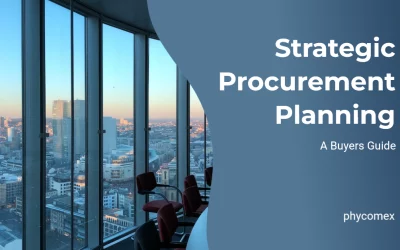The procurement process is a critical aspect of any organization’s operations, as it involves acquiring goods and services required for the smooth functioning of the business. However, procurement processes can be complex, time-consuming, and often prone to errors, leading to inefficiencies and cost overruns.
To address these challenges and optimize procurement operations, organizations need to adopt modern procurement tools and strategies that leverage automation, spend analysis, strategic sourcing, and supplier performance monitoring.
In this article, we will explore the procurement process flow, types of procurement, procurement challenges, and ways to optimize procurement using various tools and techniques. We will also introduce Kissflow Procurement Cloud, a cloud-based procurement automation tool that can help organizations streamline their procurement processes.
By adopting an optimized procurement approach, organizations can achieve cost savings, improve productivity, and enhance their overall business performance.
Key Takeaways
- Modern procurement tools can transform procurement strategies overnight.
- Procurement involves compliance with internal policies, legal requirements, and supplier agreements.
- Strategies to optimize procurement process include automation, centralization, spend analysis, strategic sourcing, clear policies and guidelines, stakeholder collaboration, integration with other systems, and supplier performance monitoring.
- Kissflow Procurement Cloud is a cloud-based procurement automation tool that can provide a centralized platform to manage all stages of the procurement cycle.
Types of Procurement
In the context of optimizing procurement, understanding the various types of procurement such as direct, indirect, reactive, or proactive can be likened to having a compass that guides organizations towards an efficient and cost-effective procurement process.
Direct procurement involves the acquisition of goods, materials, and/or services for manufacturing purposes. This type of procurement is considered strategic and requires a deep understanding of the market, supplier relationships, and the organization’s needs.
On the other hand, indirect procurement involves sourcing and purchasing materials, goods, or services for internal use. This type of procurement is more tactical and focuses on the organization’s operational needs, such as office supplies or IT equipment.
Proactive procurement involves a strategic approach to procurement that anticipates future needs and takes steps to ensure that the organization is prepared to meet them. This type of procurement emphasizes building strong supplier relationships, identifying potential risks, and developing contingency plans.
Reactive procurement, on the other hand, is more tactical and focuses on responding to immediate needs. While reactive procurement can be effective in some situations, it can also lead to higher costs and missed opportunities for savings.
By understanding the different types of procurement and their respective strengths and weaknesses, organizations can develop a procurement strategy that is tailored to their specific needs and goals.
Procurement Process Flow
The series of steps required to obtain goods or services, from needs recognition to record keeping, is known as the procurement process flow. This process is crucial for organizations as it ensures that the necessary goods and services are acquired efficiently and effectively.
However, relying on outdated tools like spreadsheets and emails can hinder the procurement process and lead to costly and inefficient results.
To optimize the procurement process flow, organizations can turn to procurement automation tools like Kissflow Procurement Cloud. This cloud-based tool provides a centralized platform to manage all stages of the procurement cycle, including sourcing, supplier management, contract management, purchases, and inventory management.
It can also integrate with existing tools to ensure a seamless flow of data and provide reports and analytics on procurement spending. By adopting such paper-driven procurement alternatives, organizations can reduce manual work, attain efficiency, and scale their procurement processes to meet their business needs.
Challenges in Procurement
Managing a fragmented supplier base and limited visibility into procurement spend can complicate tracking and analyzing expenses in the procurement process. Procurement teams struggle to streamline suppliers and monitor their performance, leading to inconsistencies in quality, higher costs, and missed savings opportunities.
Additionally, without proper visibility into procurement spend, organizations may find it challenging to analyze and track expenses, hindering their ability to optimize procurement operations.
To overcome these challenges, organizations can take measures to reduce maverick spending and centralize procurement processes. Implementing clear policies and guidelines for procurement can help ensure compliance with internal policies, legal requirements, and supplier agreements.
By integrating procurement with other systems and automating purchase processes, organizations can reduce manual work and attain efficiency. With a centralized platform like Kissflow Procurement Cloud, procurement teams can manage all stages of the procurement cycle, including sourcing, supplier management, contract management, purchases, and inventory management, while also providing reports and analytics on procurement spending.
Procurement Metrics
Procurement KPIs serve as a powerful tool for evaluating the effectiveness and efficiency of procurement processes by providing quantitative measurements and insights. Measuring success in procurement involves analyzing various metrics, including cycle time, cost savings, supplier performance, contract compliance, and spend analysis. These metrics help procurement professionals identify areas of improvement, optimize processes, and drive strategic decision-making.
Data analysis plays a critical role in tracking and analyzing procurement KPIs. By leveraging data visualization and analytics tools, procurement teams can gain insights into procurement trends, supplier performance, and spend analysis. These insights can help them identify opportunities to reduce costs, improve supplier relationships, and streamline procurement processes.
Effective use of procurement metrics and data analysis can lead to improved procurement performance, cost savings, and increased stakeholder satisfaction.





0 Comments